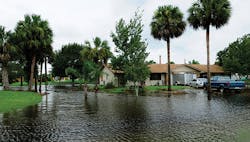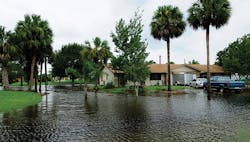By Gerard Charles Frost and Deirdre Frost
The recent report "Reducing Coastal Risk on the East and Gulf Coasts"1 discusses the five-year effort of the U.S. Army Corps of Engineers together with industry and academia to address the problem of reducing coastal risk in the East and Gulf Coast areas.
In the aftermath of catastrophes like Hurricane Sandy, it has become critical to assess risk realistically and find cost-effective solutions to respond to the impacts of coastal hazards and climate. The report reviews how risk management, plant operations and maintenance managers can reduce flood risks from coastal storm surges and minimize downtime or business interruption. Further, it demonstrates the importance of pre-planning to assess hazards and determine the emergency procedures that need to be in place for complete recovery to be accomplished quickly.
Contingency planning is critical in view of the fact that the East and Gulf Coasts have experienced greater hurricane activity and storm-related losses during the past century, largely due to increases in populations and development of the most susceptible coastal areas. Key operations in these regions have been vulnerable as coastal storms threaten critical infrastructure such as municipal drinking water and wastewater treatment facilities, power plants, and other facilities.
In particular, power plant outages from storm-related activity can create havoc, especially in urban areas. Large cities like New York City, Boston and Miami, along with other smaller cities and developed areas, would find their extensive assets to be at risk from coastal storms. The goal then is to prevent damages from coastal flooding by appealing to stakeholders, including the investment community, to fund environmental projects.
The main purpose of the report is to develop a national vision to manage coastal storm risk and respond to the increasing risks of loss. "Reducing Coastal Risk on the East and Gulf Coasts" focuses on the coastal risk-reduction strategies and levels of protection that must be established in order to reduce the impacts of coastal flooding and surges on the East and Gulf Coasts. This vision relies on plant managers, departments and suppliers to implement risk management procedures that ensure protection from coastal disasters.
Overall objectives are to develop initiatives to curtail coastal flooding associated with storm surges, but it is also in the public interest to provide safety measures to protect against major storm surges and prevent other environmental damages. The consequences are significant, considering that "nearly 5 million people live in 2.6 million homes at less than 4 feet above high tide."2 Projected increases in sea level would have negative impacts on dense populations, if not adequately prepared.
Measures to reduce surge advancement cannot rely only on nature-based features such as barrier islands, vegetated dunes and coastal wetlands. Coastal risk practices need clear, contingent plans to reduce major storm risk by reintroducing ecological and conservation practices, as well as incorporating hard structures such as seawalls or levees to serve as buffers in coastal communities and regions.
"Reducing Coastal Risk on the East and Gulf Coasts" calls for a unified, collaborative vision for sustaining and developing effective coastal risk management strategies. Implementation requires close coordination of public and private enterprises to set mutually agreed-upon goals for reducing coastal risks. A top priority is to develop assessment strategies to identify current and potential hazards, as this would encourage outside investment and create greater interest in risk reduction.
The report suggests that, contrary to current practices, funding should take place before a disaster occurs. To support this vision, it identifies areas with the greatest need for risk reduction efforts. Evacuation and other pre-disaster planning would be used to mitigate the level of risk at the local level. The report also discusses the significance of expanding the levels of protection while closely monitoring operation and maintenance costs as well as the availability of resources.
The report recommends reducing coastal risk through adaptive management practices and mitigation strategies. It suggests that managers use a benefit-cost analysis for evaluating options and encouraging investors to fund coastal risk projects. A key recommendation is to be proactive in initiating plans before disasters occur in an effort to build resiliency within coastal communities. Another is for plant operators, engineers and policymakers at national, regional, state, and local levels to build consensus for a disaster management plan and obtain commitment from investors to support coastal risk reduction.
About the Author: Gerard Charles Frost is a chemical engineer who has worked in the water treatment industry for over 40 years. As the former owner of a water treatment company, he has major experience in using water treatment techniques for commercial and residential applications. Frost and his daughter, Deirdre, are actively involved in teaching and mentoring university students interested in environmental and water resources engineering. Through teaching and writing, they continue to inspire individuals to become passionate about water. For further details or comments, e-mail them at [email protected].
References
1. U.S. Army Corps of Engineers. "Reducing Coastal Risk on the East and Gulf Coasts," National Research Council of the National Academies, The National Academies Press, Washington, D.C., 2014.
2. Strauss, Ben, C. Tebaldi, R. Ziemlinski. "Surging Seas: Sea Level Rise, Storms & Global Warming's Threat to the U.S. Coast," Climate Central, March 2012.




